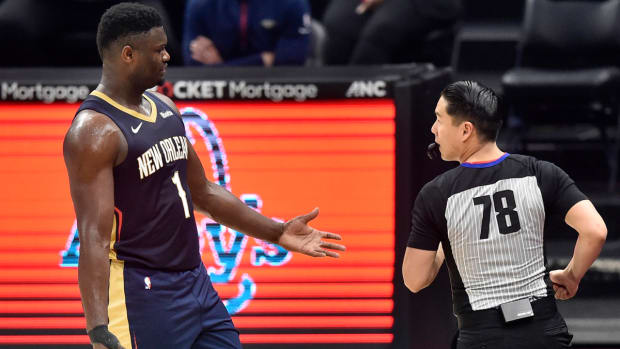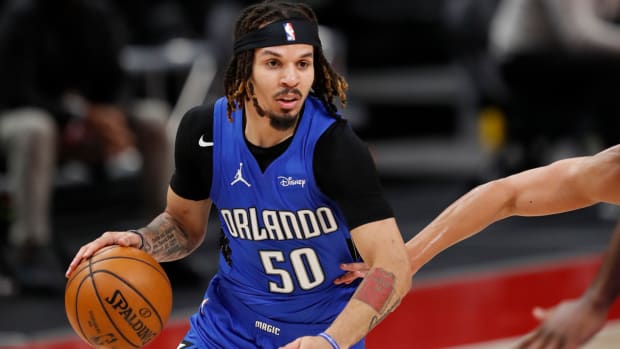Williamson's unprecedented blend of aggression, explosion, size, and strength makes him one of the hardest players to officiate.
Welcome to the Morning Shootaround, where every weekday you’ll get a fresh, topical column from one of SI.com’s NBA writers: Howard Beck on Mondays, Chris Mannix on Tuesdays, Michael Pina on Wednesdays, Chris Herring on Thursdays and Rohan Nadkarni on Fridays.
On the continuum of truly dominant, generational figures who present physical challenges that don't have any answer, Zion Williamson might already be the NBA’s most irrepressible force since Shaquille O’Neal. At only 20 years old, Williamson isn’t just averaging 27.1 points on 61.4% shooting while attempting more free throws than any other player—he’s doing it without even pretending to keep defenders honest outside the lane.
In only his second season, Williamson is more proficient in the restricted area than any player since at least 1997, and, naturally, leads the entire league with 20.3 paint points per game. It’s a number nobody has sniffed since O'Neal’s championship years in L.A. (For context, LeBron James has never topped 15 points in the paint per game.)
But there’s another critical connection between O’Neal and Williamson. What made Shaq so singular was that in addition to flummoxing the opposing team, he also made life extremely hard on referees. “You would come off the floor with Shaq when you had that matchup for the whole game and your head was splitting,” says Don Vaden, a former NBA referee who worked more than 900 games and served as the NBA’s director of officials from 2011 to 2016. “You had a migraine.”
Inside the court’s most coveted space, where ground is hardly ever conceded without precipitous contact, O’Neal was nearly as hard to officiate as he was to guard. It led Sports Illustrated to report an entire feature back in 2001 that asked “has the Los Angeles Lakers superstar become unrefereeable?”
Two decades later, Williamson is generating some of those same nightly conundrums in his own remarkable way. He’s a novel test for officials who, along with everybody else, have never seen a player pull off the same physical feats he consistently does. Watching him play basketball is to look at evolution succeed in real time.
“There's a lot of people that are 6' 6", 6' 7", 6' 8", 6' 9", but there's nobody that's 284 [pounds] and moves with the speed, quickness, agility that he does,” Vaden says. “Zion is one of the most powerful players I've ever seen.”
In 2018, Vaden stepped down as the WNBA’s director of officials and has since worked as a consultant for teams and players around basketball. On an average day, he takes in two or three NBA games. (Last week, he texted me from his seat in one arena while simultaneously watching a different game on his iPad.)
In addition to O’Neal, two players Vaden remembers being a distinct challenge were Charles Barkley and Karl Malone. Since, several others have been tricky: LeBron, James Harden, Giannis Antetokounmpo, Joel Embiid, etc. But Williamson is unique in that just about all of his most impactful plays are abrupt and at the rim. When compared with O’Neal, their respective eras are a huge factor in separating how exactly they were so tough for officials: changing rules have altered defensive strategy.
O’Neal was almost always matched up with one defender who he’d battle for position before someone passed him the ball. (Zone defense wasn’t legalized until the 2001–02 season.) The fight would continue after he caught it, and again when he’d kick the ball back out and repost. There was a perpetual gray area, but only one of the game’s three referees usually dealt with it on any given possession.

It’s different with Williamson, who doesn’t plant his flag on the block like O’Neal did. Instead, often moonlighting as a point guard, he’ll either drive the ball from the perimeter or catch a pass 15 feet out and then rumble in from there. By the time he reaches the basket, more than one defender will in all likelihood have had a chance to slow him down, complicating what officials have to deal with before a point of contact is made.
That uncanny combination of size and speed impacts the anticipatory decisions officials normally make. The three basic elements of refereeing are location adjustment, position adjustment and vision adjustment. There’s a lead official (somewhere along the baseline, ideally on the strong side), a slot official (free throw extended, near the sideline), and a trailer. Possessions involving Zion tweak their individual responsibilities a bit and force all three to focus on spots they otherwise don’t.
“When [the Pelicans] swing it back to the weak side, and Zion puts it down going to the basket, the lead doesn't have a chance to get there,” Vaden says. “And the slot is basically trying to referee that play by himself—with help, but there's a lot more pressure on [them] that way.”
In these spots, the lead official often has no choice but to observe from the opposite side of the lane, which isn’t preferable. Even still, referees don’t stare at Williamson so much as they focus on different defenders who appear on his path to the rim.
“You're picking up the defender that can hurt you the most, and with Zion a lot of times that defender is changing from primary to help to secondary,” Vaden says. “And to me that's the reason why he is so difficult to referee, because there's multiple defenders involved almost every time. And then he's always getting his own rebound. So now you’ve got a fourth layer. You got the rebounding situation.”
Depending on your perspective (i.e., which team you work for), Zion draws either too many fouls or not nearly enough. Frustration on behalf of those who subscribe to the latter spilled overboard at the end of a recent loss against the Denver Nuggets, when Nikola Jokić appeared to smack Williamson’s wrist at the rim near the end of a one possession game. No whistle blew. The following day, the game’s two-minute report corrected the non-call and said Jokić should’ve been called for a personal foul.
Afterward, Pelicans coach Stan Van Gundy expressed his displeasure with how his best player has been officiated all year. “He gets to the free throw line a lot, and I've had referees say to me, ‘How many free throws has he shot?’ and it's a stupid question. It doesn't matter. Call it every single time he gets fouled. That's all your job is,” Van Gundy told reporters. “It's not a matter of, ‘Oh, he shot eight free throws,’ or,’'Oh, he shot 10 free throws.’ Some nights he should shoot 20. So call it. That's all. Just call it. What more does he have to do to get those calls? … I do think strength gets punished in this league a lot more than quickness. If you're able to go through contact a little bit, it's called differently.”
That play was singled out because of when it occurred and the stakes involved, but watch any Pelicans game from start to finish and what you’ll see are a series of question marks created by one of the league’s strongest players. “He's going to the rim every time,” Lonzo Ball told reporters. “There are fouls; they aren't calling them.” Nobody seeks out close-quarters combat as often as Williamson does, and arguably nobody puts more pressure on those who have to adjudicate a rule book that wasn’t written with the thought that someone this fast and powerful would ever exist.
“When he dunks the ball, you or I can reach out and hit him as hard as we want to, he's not even gonna feel it. He's going to be able to finish with power. And from a referee standpoint, they're trying to get their eyes to the point of contact, but he goes through it so powerful that you can't tell if he's hit or not,” Vaden says. “Most of the time, you're not gonna see it until you go to replay or go to the film session later and look at it in slow motion to see if there is actually contact or not.”
To his credit, Zion has taken all of this in stride. “I gotta earn my respect,” he said after the Nuggets loss. “I'm only in year two. Gotta get a couple more years under my belt and hopefully things change with that."
Williamson is patient now, at the dawn of a Hall of Fame career, with a skill set that will (probably) diversify and a roster that will (hopefully) complement him better than New Orleans’s current one does. But the number of judgement calls that are created by his unprecedented blend of aggression, explosion, size and strength aren't going anywhere anytime soon. Because of those split-second decisions, neither will the spotlight that hovers over Zion’s relationship with the whistle. It isn’t the most important variable to keep an eye on as his impossibly thrilling career continues to unfold, but it’s also far from insignificant in a very specific way.
WHAT DO THE MAGIC HAVE?

Orlando ended April with the NBA’s second-worst offense and third-worst defense. Literal months into an extensive rebuild, the franchise car keys have been handed to a collection of inexperienced prospects who, at first glance, are diametrically opposed to more coveted positional archetypes found in today’s NBA. It’s an understandable mess.
Cole Anthony, Wendell Carter Jr., Chuma Okeke, R.J. Hampton and Mo Bamba are the active members of an intriguing, talented and flawed youth movement. Jonathan Isaac and Markelle Fultz have been out of sight, out of mind all season, but still factor into the Magic’s long-term plans.
In that list, there are no wings. None of the guards or bigs are knockdown shooters. And, most importantly, there is no obvious star (though Isaac may be one before it’s all said and done). But let’s take a quick peek into the future, where this year’s draft may be Orlando’s most important since Dwight Howard was selected. Is their next true centerpiece months away from climbing aboard? And, a more intriguing question, how many of this current roster’s pieces are good enough to surround him with?
As ESPN’s Mike Schmitz said on a recent episode of The Hoop Collective, some believe there are five No. 1–caliber picks in this year’s draft. Now, remember that blockbuster deadline-day trade the Magic made with the Bulls, when—for the purpose of this conversation—Nikola Vucevic was swapped for two first-round picks?
The pick Chicago owes Orlando in this year’s draft is top-four protected. But given the Bulls’ collapse (they won’t be qualifying for the play-in tournament), the door is technically open for not one, but two franchise-altering talents. It’s tempting to ignore the Magic, but keep an eye on how their youngsters play. They feel irrelevant right now, but could be important before you know it.
More NBA Coverage:
• Mannix: Sorry LeBron, the Play-in Is Here to Stay
• Power Rankings: Time to Worry About the Lakers?
• What's Next for the Knicks?
• Prewitt: Do Triple-Doubles Really Matter?